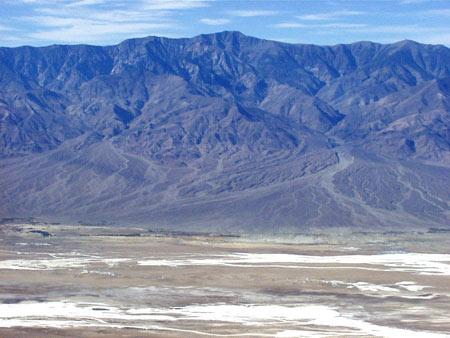[This story has been updated with additional information made available since it was initially posted.]
It was intended to be a one-night camping trip to Death Valley National Park for a mother and her 11-year-old son, but they were stranded for five days after their vehicle became stuck in an isolated section of the desert. The mother was eventually rescued, but her son failed to survive the intense heat.
Authorities are still piecing together the details, but the tragic incident apparently hinged at least in part of the use of a GPS unit for navigation in a remote area with few landmarks.
Alicia Sanchez, 28, and her son Carlos, age 11, left Las Vegas on Saturday, August 1, for an overnight camping trip to Death Valley National Park. It's not clear why they ended up in one of the most remote sections of the vast desert park.
Sanchez apparently had no maps, but reportedly relied on a GPS unit in her vehicle for directions in the desert. After their vehicle became stuck in the sand, a hike to a peak in an attempt to get a cell phone signal was unsuccessful. The pair then remained with their vehicle, along with their pet dog; they tried to survive on the supplies they brought from home, including bottled water and snacks.
No one else was even aware the pair was in the extremely remote area until family members from other parts of the country contacted authorities late Wednesday afternoon. According to a park report,
The family reported Sanchez planned to come to the park with her 11-year-old son to camp and visit Scotty’s Castle, and that she’d sent a text message on August 1st saying that she was in the desert and changing a flat tire.
There were no further details about her plans or last known location.
Ranger Matt Martin checked the high elevation campgrounds in the Panamint Mountains (Wildrose, Mahogany Flats, and Thorndike) and district ranger Aaron Shandor checked the Furnace Creek campground and the surrounding developed area – neither with any success.
Rangers then began planning for a full-scale search beginning at first light on Thursday, August 6th, including the use of a VX-31 SAR helicopter from China Lake Naval Air Station. The VX-31, with rangers providing ground support, began searching the south end of the park at 6 a.m., as did other rangers and members of the Civil Air Patrol.
At 10 a.m., ranger Amber Nattrass came upon a wheel rim with a flat tire and a water bottle on a dirt road leading into the Owlshead Mountains at the southwest corner of the park. Only one set of tire tracks were seen. Nattrass followed this set of tire tracks and discovered that the vehicle had left the established roadway and been driven into designated wilderness.
Nattrass continued to follow the tracks and found Sanchez’s vehicle just after 11 a.m. She found the woman conscious but suffering from exposure and severe dehydration; her son had not survived. Nattrass, a park medic, began treating Sanchez after requesting a medevac. VX-31 with paramedics on board responded, and they began assisting Nattrass with medical care.
A medevac helicopter from Mercy Air in Pahrump, Nevada, arrived and transported Sanchez to Sunrise Hospital in Las Vegas.
“It’s in about as remote and isolated an area as you can find,” Death Valley National Park Chief Ranger Brent Pennington told the Associated Press. “How she got to that point, I don’t know.”
Summer high temperatures at Death Valley commonly run above 120 degrees Fahrenheit, and were reportedly near 111 degrees in the area of the incident on Tuesday and Wednesday.


 Support Essential Coverage of Essential Places
Support Essential Coverage of Essential Places







Comments
I want to comment on R Stefancik's post "If this mother and son could have managed 3 mi/hr, they could have covered 30 miles in 10 hours."
You have my admiration, Stefancik, you must be in pretty good shape if you think so little of covering that kind of ground. That's a LONG way for the average person, a longer way for an 11 year old. Obviously these were not folks who made a habit of those kinds of hikes or they'd have had more water, food, and maps. Plus it's still pretty hot in Death Valley at night in the summer, and without a lot of water...they'd never have made it. The right choice given the circumstances was to stick with the car. Hopefully other folks will see this story and take their own precautions before they travel into that kind of area.
I did address verifying for the Census earlier this year. We had to use handheld GPS units. At one point, as I was trying to spot a particular house, I noticed that the GPS told me I was at least a football field to the west, in the middle of a set of railroad tracks, down which a freight train was thundering. If the GPS had been right, I'd be roadkill right now!
We increasingly think technology -- GPS, cell phones, "I saw it on the Internet so it must be true" -- is 100 percent trustworthy. It ain't!
In almost all cases, its not the GPS that's wrong, its the maps or images loaded onto it. "Roads" can come from databases that include undeveloped rights of way; even rectifying (aligning and scaling) aerial ortho photographs is non-trivial in places like the Everglades and playas in Death Valley. [Those large white crosses you see painted on some urban streets and rural rural roads are marks to ease rectification of aerial photographs.] I've never had a GPS give me coordinates off by more than 15 meters or so (closer to 2-3m now with WAAS and the demise of selective availability), although one does have to make sure you have the coordinate system (NAD27 v NAD83) set the way you think.